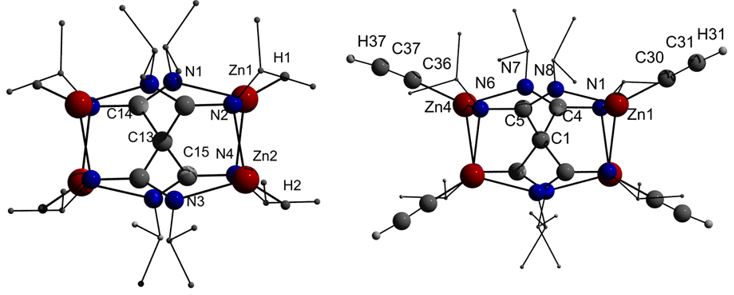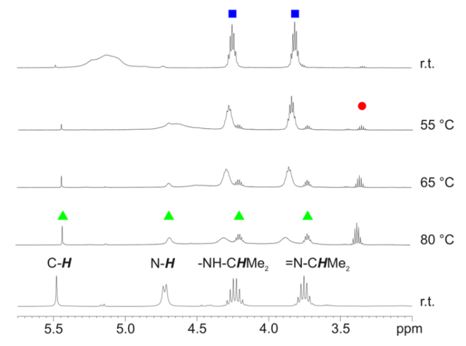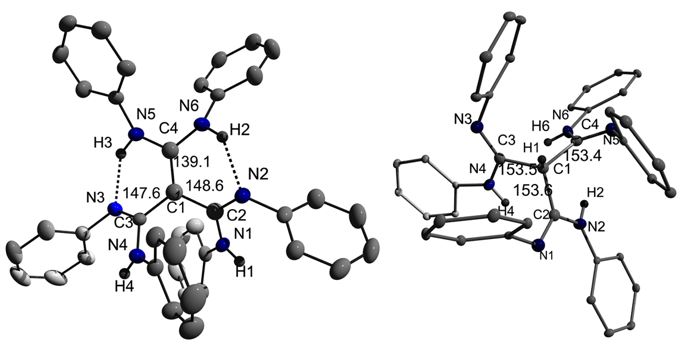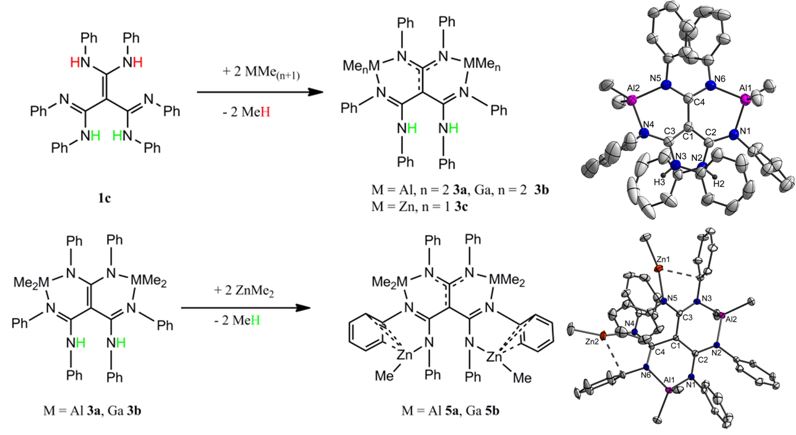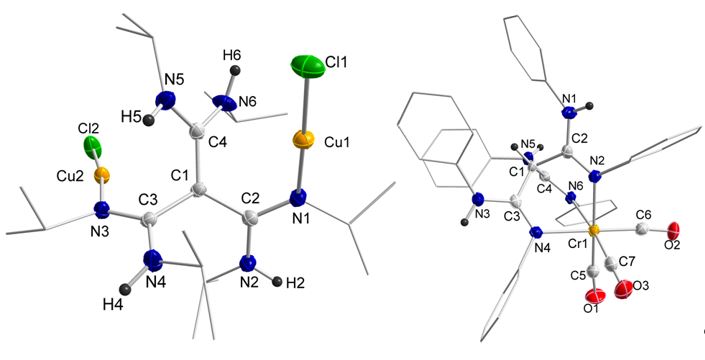Reactions of tetraamidinate zinc complexes
Reactions of tetraamidinate zinc complexes
{C[C(NiPr)2ZnMe]4} was also shown to be a suitable starting reagent for other multinary amidinate complexes. Reactions with aluminum trihalides AlX3 (X = Cl, Br, I) occurred with Me/X exchange and subsequent formation of the corresponding zinc halide complexes.[1]
These complexes react with two additional equivalents of MCl3 (M = Al, Ga) with formation of the corresponding Lewis acid-base adducts {C[C(NiPr)2ZnCl]4[MCl3]2} (M = Al, Ga),[2] while salt elimination reactions with MeLi, n-BuLi, EtMgBr, NaC≡CPh and CaH2 gave the correspondiing tetranuclear amidinate complexes of the general type {C[C(NiPr)2ZnR]4} (R = Me, Et, n-Bu, C≡CPh, H).[1]
The zinc hydride complex {C[C(NiPr)2ZnH]4} is very reactive and was used for the synthesis of acetylene complexes {C[C(NiPr)2Zn-C≡CH]4} and {C[C(NiPr)2Zn-C≡CH]4} by reaction with HC≡CR (R = Ph, H).[3]
In an attempt to synthesize the protonated tetraamidine, we reacted {C[C(NR)2ZnMe]4} (R = i-Pr; P) with water.[4] Monitoring the reaction of {C[C(Ni-Pr)2ZnMe]4} by temperature dependent in situ 1H-NMR spectroscopy in C6D6 showed that this complex is almost stable against hydrolysis at ambient temperature, while heating to 55 °C exclusively yielded (i-PrN)2C and methanetrisamidine HC[C(NHi-Pr) Ni-Pr]3.
In contrast, hydrolysis of {C[C(NPh)2ZnMe]4} yielded both tautomers C[C(NPh)N(Ph)H]2[C(HNPh)2] and HC[C(NHPh)NPh]3, which are the first structurally characterized CH-NH tautomers of an acyclic amidine.
The trisamidines are reactive starting reagents in reactions with organometallic complexes and were shown to produce both homoleptic metal complexes in reactions with AlR3, GaR3, R2AlH and ZnR2.[4,5] For instance, reaction of HC[C(NHPh)NPh]3 with AlR3 occurred with elimination of alkane and formation of HC[C(Ni-Pr)2AlR2]3. Moreover, the N-H groups can be stepwise addressed in metalation reactions since the N-H acidity differs. As a consequence, heterobimetallic complexes were successfully synthesized.[5]
In addition, methanetrisamidines {HC[C(NR)NHR]3} (R = i-Pr; Ph) are valuable strating reagents in coordination chemistry.[6] Reaction with NiCl2(H2O)6 occurred with protonation and formation of {[C(C(NHi-Pr)2)3]2+[NiCl4]2−}, while the reaction with CuCl gave [C(C(N(i-Pr)CuCl)NHi-Pr)2(C(NHi-Pr)2)]. Both complexes show the N-H tautomeric form, resulting from a H-migration from carbon to nitrogen. In contrast, reactions of {HC[C(NPh)NHPh]3} with [M(NCMe)3(CO)3] (M = Cr, Mo, W) yielded octahedral complexes fac-[M(CO)3CH(C(NHPh)NPh)3], in which the C-H tautomeric form is preserved.
References
[1] B. Gutschank, S. Schulz, U. Westphal, D. Bläser, R. Boese, Organometallics 2010, 29, 2093.
[2] S. Schmidt, B. Gutschank, S. Schulz, D. Bläser, R. Boese, C. Wölper, Eur. J. Inorg. Chem. 2011, 28, 4464.
[3] B. Gutschank, S. Schulz, D. Bläser, R. Boese, C. Wölper, Organometallics 2010, 29, 6133.
[4] B. Gutschank, S. Schulz, M. Marcinkowski, G. Jansen, H. Bandmann, D. Bläser, C. Wölper, Angew. Chem. Int. Ed. 2012, 51, 10893.
[5] B. Gutschank, M. Bayram, S. Schulz, D. Bläser, C. Wölper, Eur. J. Inorg. Chem. 2013, 31, 5495.
[6] B. Gutschank, S. Schulz, D. Bläser, C. Wölper, J. Chem. Soc., Dalton Trans. 2014, 43, 2907.





